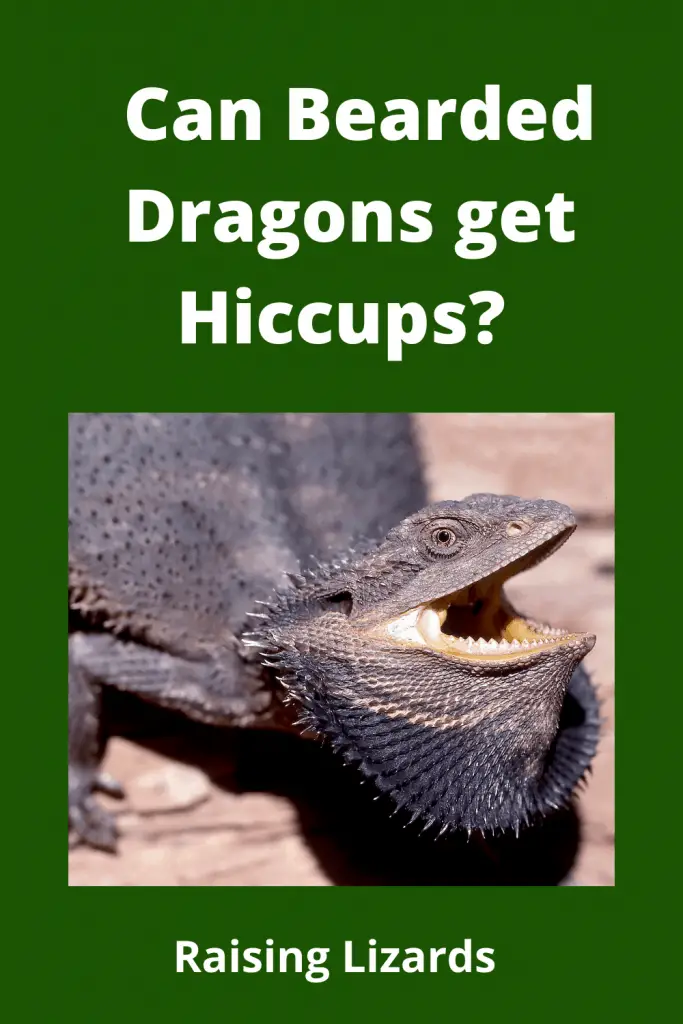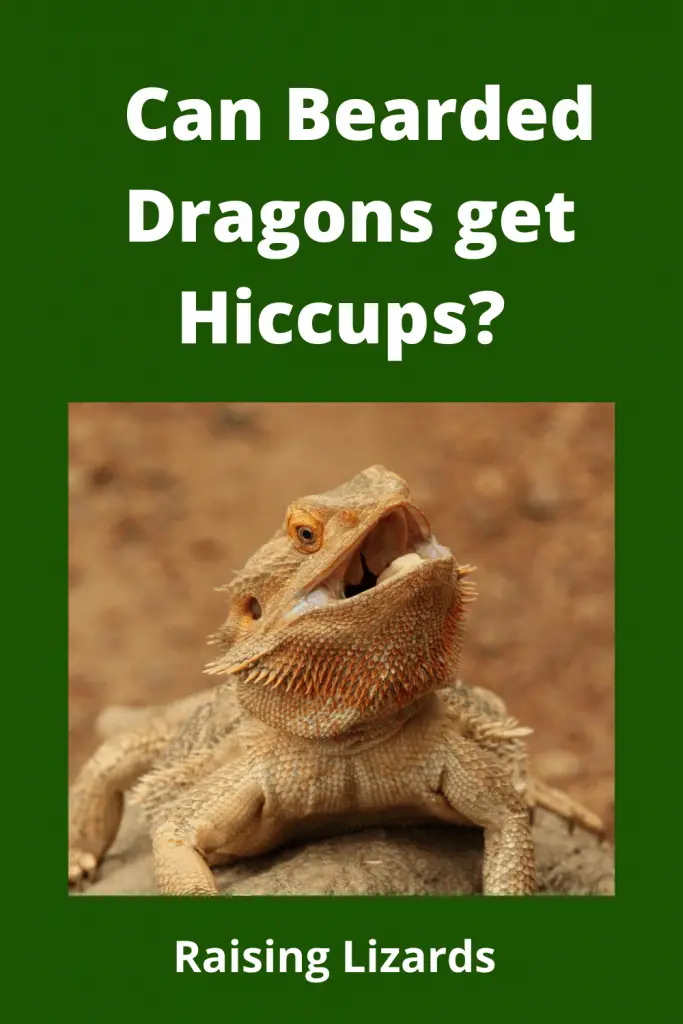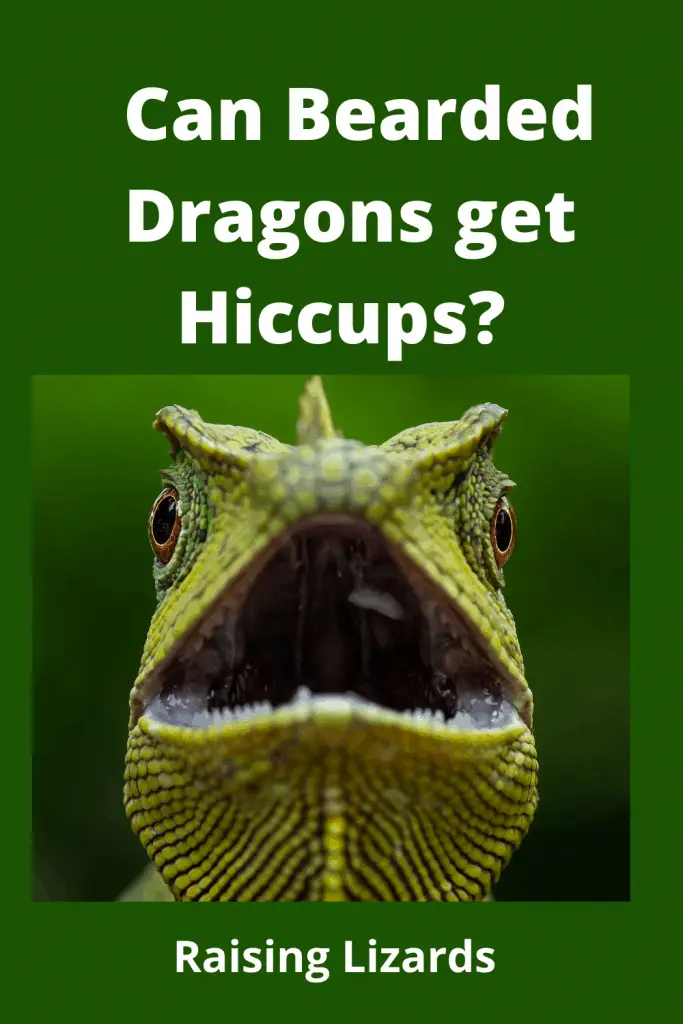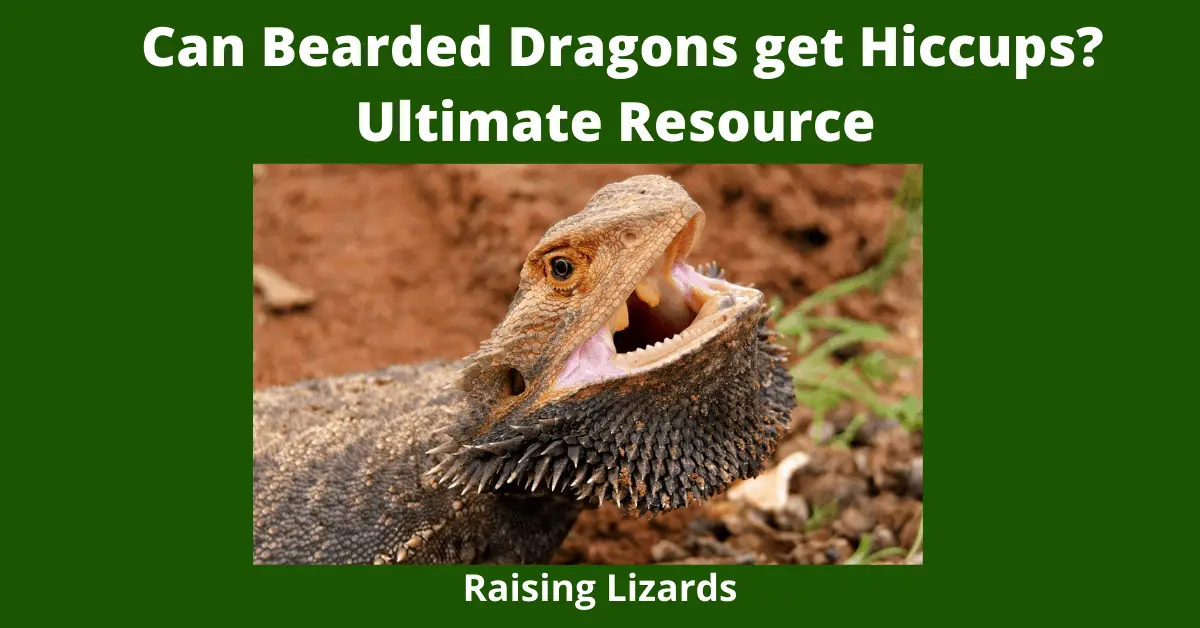There’s been a lot of debate on the internet on whether bearded dragons get hiccups or not. There will be the answer to this question in this post.
Although bearded dragons are unable to hiccup( according to scientists), many owners have experienced and reported this behavior in their reptiles: ( or at least something very similar), spontaneously spasms or involuntary hiccup spasm. Since information and facts differ so much, people get confused and scared easily.

Why Can a Bearded Dragons Get Hiccups
Let’s set this straight from the beginning; so, many bearded dragons have been observed to be getting this kind of hiccup behavior. Bearded dragon owners report occurrences on their reptiles, prompting a repetitive hiccup-like behavior.
Hiccups are uncontrollable spasms that occur in the diaphragm muscle in humans and other mammals. The closing of a part of the vocal cords causes the characteristic “hic” sound. In most cases, hiccups are not severe medical concerns, and they eventually go away on their own.
That said, hiccuplike behavior in companion animals can be troubling for an owner. Bearded dragons are captive pets who do not possess movable diaphragm muscles and, as such, cannot hiccup. Other behaviors of the bearded Dragon, such as mating calls and threat displays, can appear to be hiccups.
Bearded Dragon Head Bobbing:
The behavior of the bearded Dragon, most similar to the mammal hiccup, is known as head bobbing or head jerking. This behavior involves the beardy lowering his head and shaking it upward. This action can be subtle, or it can be violent enough to start the whole front part of the lizard’s body upward. Head bobbing is a widespread courtship behavior among male bearded dragons, even when no female is present.
Panting During Basking:
Reptiles like the bearded Dragon are cold-blooded; they require periods of basking in a warm place to raise their body temperatures. Beardies have been known to hold their mouths open while basking to help fine-tune their temperature, occasionally also panting.
This painting may be quick and may be mistaken for hiccups. A healthy bearded dragon must be offered a temperature gradient in his enclosure so. He can self-thermoregulate freely. A dragon who lacks the slope and is overheated may always pant.

Basking:
Basking under a heat lamp or in full sunshine is a behavior that beardies exhibit daily. That way, they collect heat and UVB radiation, which helps create vitamin D3 to metabolize calcium. As said above, many bearded dragons will flatten their bodies and turn darker to soak in as much warmth and ultraviolet light as possible.
Open Mouth Display:
The bearded Dragon is named for the flap of skin on the jaw’s underside that he can inflate with air to appear larger and scare off incoming predators and other threats. When raised, it looks like the Dragon has a large, dark beard.
The open mouth display is a common defense that most beardies aren’t used to being handled or being around humans with the initiate. They open their mouth and rapidly inflate their beards. If done in succession, this behavior can resemble hiccupping.
Bearded Dragon’s Respiratory System:
Bearded dragons use their lungs for breathing, and their respiratory system is unlike that of mammals. Bearded dragons do not have diaphragm muscle for lung ventilation, meaning that the muscles used for their respiratory system are the same as the muscles used for locomotion.
According to zoologists and scientists, there are no documented hiccups in reptile, amphibians, or birds.
Respiratory Infection Behaviors:
If your bearded Dragon has abnormal behavior, excess of saliva, some sneezing, or breathing unnaturally, then it is time you and takes your bearded Dragon.
Respiratory Infection Symptoms:
There are the following symptoms of Respiratory infection in bearded dragons. Respiratory infection represents the growth of bacteria in the lungs.
Respiratory infection is caused by high humidity levels and needs to be treated immediately.
- Unnaturally hard breathing:
As if the bearded Dragon has been running.
- Open mouth breathing:
. Mouth gaping is forced exhalation are signs of a respiratory infection that should be immediately followed up with a veterinarian visit.
- Some sneezing:
They are trying to clear mucus from their lungs.
- Clicking sounds:
A clicking sound will be occurred due to the mucus in their nose and lungs.
- Liquid coming out of their mouth and nose:
The liquid will come out of their mouth and nose. It will show the infection in the respiratory tract.
- Excess of saliva:
Excess of saliva is another symptom of respiratory infection in the bearded Dragon.
- Sleeping with their head up and switching the head while sleeping:
They are trying to breathe and are having a hard time doing so.
Like all reptiles, proper care and housing are essential to maintaining a happy and healthy bearded dragon. Even with the best care, beardies will sometimes get sick. Respiratory infections are not uncommon.
If the reptile displays any other symptoms, you should call your veterinarian as snakes are usually very good at hiding illnesses until they are severe.
Hiccup-Like Behavior in Bearded Dragon:
In most cases, bearded dragon hiccups are caused by feeding, air swallowing, or belly distension and go away independently with no lasting effects.
The reasons listed below represent the opinions and estimates of exotic veterinarians and bearded dragon owners’ incidences reports. Generally, most bearded dragons started to exhibit a hiccup-like behavior just after they were feed.
This challenging topic has raised my attention and interest for a long time. Therefore, there are the following common causes of hiccup-like behavior in bearded Dragon.
Causes of Hiccup-like Behavior in Bearded Dragon:
- Swallowing without thoroughly chewing.
- Swallowing air while eating or drinking
- Aspirating food
- Eating quickly: this will occur when they eat too fast.
- Choking while eating or drinking.
How to react with Bearded Dragon while Hiccups:
Don’t freak out: First and foremost, keep calm and not freak out or get scared. People mistake very often these situations and assume it’s a respiratory infection. Bearded dragons are more substantial than other reptiles and do not get a respiratory infection as quickly as other reptiles such as chameleons.
For most bearded dragons, it happened as a one-time event. The dragons haven’t had them since, were acting normal, and they were perfectly fine and healthy after the event. They also didn’t seem bothered, disturbed, agitated, or negatively impacted by these hiccups.
As a pet parent, it is normal to feel worried as you genuinely care about your bearded Dragon, which is why we want to ask the following questions before freaking out.

Did the Hiccups Occur just after Eating/Drinking:
In this case, hiccups were probably caused by swallowing, fast eating, or drinking, and there is no need to worry. However, it was suggested that you keep an eye on your Dragon’s behavior and make sure this is not happening too often.
Was it a one-time occurrence?
Keep observing if your bearded Dragon is eating, drinking water, being active, and acting normal. If hiccups were a one-time event and afterward everything seems to be okay with your bearded pet, it can only mean that your Dragon is safe and healthy.
Bearded Dragon Behavior and Body Language:
Just because bearded dragons are not vocal, that doesn’t mean that they do not communicate. Beardies use body language to interact with members with their species and other creatures they encounter.
Humans do not understand these signals intuitively. We have learned about them through study and observation. It is essential for every bearded dragon owner to learn to interpret the gestures of their pets.
Common Behaviors of Bearded Dragons Include:
- Head bobs
- Waving
- Changing color
- Mouth gasping
- Beard puffing up
- Tail pointing upwards
- Basking
- Hiding
Abnormal and Undesirable Behaviors of Bearded Dragons Include:
- Lethargy
- Wobbly walking
- Lack of movement
- Moving the front legs only
- Twitching or jerking movements
- Looking upwards for no reasons
- Soaking too much
Additionally, some common behaviors should be interpreted as abnormal if they are prolonged or if they appear in an unusual context. For example, while it is normal for the Dragon’s beard to turn black when he is excited, the beard that is dark all the time indicates that your beardie is distressed or in pain.
That is why it is worthwhile to take a more in-depth look into bearded dragons’ common behaviors.
Why do Bearded Dragons Wave?
When you appear in front of your beardie, sometimes he will raise his front foot and wave at you.
This greeting essentially says two things am here, and I cam in peace, don’t hurt me. It’s both a signal of presence and submission. That is the reason why insecure young beardies will perform the wave more often than mature adults.
Why is My Bearded Dragon Turning Dark or White?
The main reason is temperature regulation. Black surfaces soak in more warmth. That is why you will often see bearded dragons turn black and flatten out in the morning when you turn on the light or take them out for a walk and basking in the natural sunlight. Some beardies will also turn black when they get aggressive.
Why is my Dragons’ Beard Turning Black?
The bearded Dragon’s trademark beard will become enlarge and dark if he is excited, scared, aggressive, and ready to attack an intruder, or ready to mate. In these cases, the black beard is a passing occurrence.
However, if the black beard is persistent, it is a sign that your beardie is suffering. He could be in pain, or there might be something wrong with his habitat. Some older bearded dragons will show an always black beard before the end of their lives.
Why is my Bearded Dragon Suddenly Pale?
If your bearded Dragon turns pale, that is a sign of an upcoming shedding. You can read more about shedding below.
Also, some beardies will get lighter when sleeping.
Do Bearded Dragons Hibernate?
Brumation is a reptile version of hibernation. It occurs within the same fall and winter period, but it is different from hibernation because reptiles do not shut down their metabolism completely that slows it down. Also, they do not sleep.
Each bearded Dragon will brumate differently and maintain different levels of activity. However, all reptiles need to stay hydrated during brumation.
While bromating, your beardie will fall into a slumber that will last for months, during which he might not eat or drink a lot or not at all. If you get worried, always remember that brumation is a natural process that should not be stopped.

What are the Signs of Bearded Dragon Brumation?
The first sign of brumation is a radical behavior change. that includes:
- Frequent hiding
- More naps and sleep look
- Sluggish movement
- Poor appetite
Otherwise, bearded Dragon ready to brumate should seem healthy with clean and elastic skin, pure eyes, no gaping mouth, or other signs of infection.
If your beardie is trying to brumate out of season or he is under a year old, it is highly likely that his health is compromised and that his behavior only mimics brumation. Low UVB lighting, improper temperature, vitamin and mineral insufficiency, vitamin and mineral insufficiency, vitamin overdose, or infections can all prompt the brumation-like behavior. The underlying causes should be addressed as soon as possible.
In nature, week or sick individuals often die during brumation. Fortunately, there are several things you can do to make sure your Dragon will go through brumation safely and wake up with plenty of strength left.
Dehydration: How Do you Know if a Bearded Dragon is Dehydrated?
Bearded dragons seldom drink water from a bowl. They get most of their fluid from their food and baths. Dehydration can be both a symptom of an illness and a stand-alone health issue.
The signs of dehydration in bearded dragons are:
- Wrinkled skin
- Skin that does not retract when gently pinched, but holds shape.
- Lethargy
- Lack of appetite.
If your Dragon becomes more lively after drinking some water, it is another sign that dehydration likely the cause of his bad shape.
Bearded Dragon Diet
| Insects | Greens | Occasional Snacks | Avoid These Foods | Toxic | Supplements / Reptiles |
|---|---|---|---|---|---|
| SuperWorms | Kale | Plumbs | Lettuce | Parsley | Gut Loaded Insects |
| Earth Worms | Cucumbers | Melons | Spinach | Chives | Calcium |
| Dubia Roaches | Cabbage | Grapes | Wild Insects/ Insecticides | Eggplant | D3 |
| Black Soldier Fly Larvae | Bok Choy | Bananas | Bees | Garlic | Cuttlefish |
| Crickets / Leave none uneaten / They can wound Your Dragon | Bell Peppers | Apples | Centipedes | Mushrooms | Multivitamin |
| Locusts | Mustard Greens | Apricots | Fireflies | Rhubarb | |
| Butterworms | Squash | Kiwi | Ladybugs | Avocados | |
| Wax Worms | Dandelion Greens | Strawberries | Monarch Butterflies | ||
| Tomatoe Hornworms | Peaches | Wasps | |||
| Phoenix Worms | Fuzzy Caterpillars | ||||
| Houseflies | |||||
| Flour Beetles | |||||
| Stick Insects | |||||
| Mice |
Lizard Habitats and Facts
| Lizard Type | Foods | Adult Size | Vivarium Type | Eggs | Temperament | Country Origin | Price |
|---|---|---|---|---|---|---|---|
| Ameiva | Insects | 20 " | Tropical Woodland | 2-8 | Aggressive | Central, South America | $ 49.99 |
| Alligator Lizard | Insects | 20" | Semi- Aquatic | 6-12 | Aggressive | North America | $ 18 |
| Asian Water Dragons | Carnivorous | 40" | Tropical Woodlands | 8-16 | Aggressive | Asia | $ 18 - $ 80 |
| Panther Chameleon | Insects | 12" | Tropical Woodlands | 30-50 | Aggressive | Madagascar | $ 150 - $ 600 |
| Jacksons Chameleon | Insects | 14" | Temperate Woodlands | Up to 30 Live Young | Aggressive | East Africa | $ 75 - $175 |
| Giant Day Gecko | Insects | 10" | Tropical Woodlands | 2 | Aggressive | Madagascar | $ 79.99 |
| Leopard Gecko | Insects | 10" | Desert | 2 | Aggressive | Asia, India | $ 30 - $ 45 |
| Tokay Gecko | Insects | 14" | Tropical Woodland | 2 | Aggressive | Southeast Asia, New Guinea | $ 39.99 |
| Blu Tongue Skink | Vegetarian | 20" | Savannah | 6-25 | Aggressive | New Guinea, Australia | $ 150 - $ 649 |
| Common Walled Lizard | Insects | 8" | Savannah | 3-8 | Aggressive | Central Europe | $ 460 - $ 600 |
| Green Lizard | Insects | 16" | Savannah | 6-20 | Aggressive | Europe, Southern Asia | ? |
| Green Iguana | Vegetarian | 60" | Tropical Woodland | 20-40 | Aggressive | Central, South America | $ 39 - $ 55 |
| Desert Iguana | Vegetarian | 15" | Desert | 3-10 | Aggressive | USA, Mexico | $ 34.99 |
| Six Lined Racerunner | Insects | 11" | Savannah | 4-6 | Aggressive | USA | $ 29.99 |
| Chinese Crocodile Lizard | Carnivorous | 12" | Semi- Aquatic | 2-12 Live Young | Aggressive | China | $ 1200 |
| Collared Lizard | Insects | 14" | Desert | 4-24 Eggs | Aggressive | USA, Mexico | $ 53.99 |
| Western Fence Lizard | Insects | 9" | Savannah | 6-13 | Aggressive | USA | $ 19.99 |
| Chuckwalla | Vegetarian | 18" | Desert | 6-13 eggs | Aggressive | Mexico | $ 88.99 |
| Green Anole | Insects | 9" | Tropical Woodland | 2 | Aggressive | Southern USA | $ 10.00 |
| Brown Anole | Insects | 8" | Tropical Woodland | 2 Eggs | Aggressive | Caribbean, Central America | $ 3.99 - $ 7.99 |
| Knight Anole | Insects | 22" | Tropical Woodland | 1-2 | Aggressive | Cuba | $ 39.99 |
| Nile Monitor | Carnivorous | 79" | Savannah | 10-60 | Aggressive | Egypt | $ 69.99 |
| Bosc's Monitor | Carnivorous | 69" | Savannah | 10-50 | Aggressive | Central Africa | $ 100 - $ 150 |
| Bearded Dragon | Insects | 20" | Desert | 15-30 | Social | Australia | $ 60 - $ 400 |
| Agama | Insects | 16" | Savannah | 10-20 | Aggressive | North Africa | $ 24.99 |
| Five Lined Skink | Insects | 9" | Temperate Woodland | 15 | Aggressive | Africa | $ 10 |
| Red Tailed Rock Lizard | Insects | 8" | Savannah | 2-4 | Aggressive | South Africa | ? |
Food
Size
Vivarium Type
Country Origin
Price
Eggs
Temperament
Approx Cost


